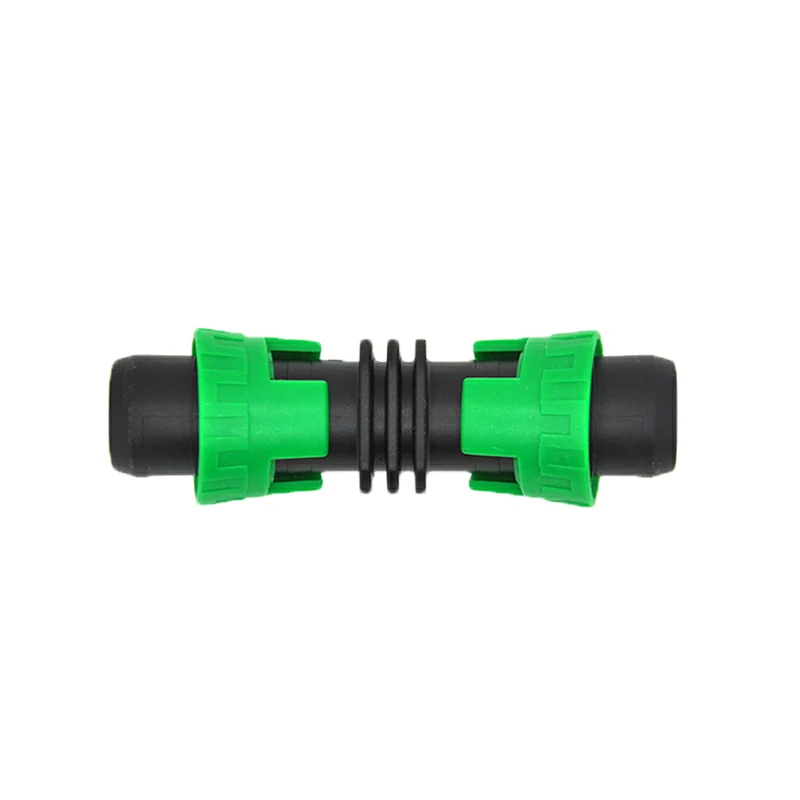When working with lock ring fittings and drip tape connections, you may encounter some common issues.
Here are a few troubleshooting tips to help address these problems:
Leakage at Connections: If you notice water leakage around the lock ring fitting connections, it may indicate an improper seal. Ensure that the lock ring is correctly positioned and tightened. Check for any damage or debris on the sealing surfaces and clean or replace the components if necessary.
Difficult Locking or Unlocking: Sometimes, lock ring fittings can be challenging to lock or unlock, especially if they are old or have been exposed to harsh conditions. Applying a lubricant or gentle twisting motion while locking or unlocking can help ease the process. Be careful not to use excessive force, as it may damage the fitting.
Drip Tape Blowouts: Blowouts occur when the drip tape bursts or separates from the lock ring fitting under high pressure. To prevent blowouts, make sure the drip tape is properly inserted into the lock ring fitting, and the lock ring is securely tightened. Avoid excessive pressure by adjusting the system’s pressure regulator or using pressure-compensating drip tape.
Uneven Water Distribution: Uneven water distribution along the drip tape may occur due to improper alignment or blockage of emitters. Check for any kinks, twists, or obstructions in the drip tape. Ensure that emitters are not damaged or clogged. Flush the system to remove any debris or sediment that may be affecting water flow.
Damage to Drip Tape: Inspect the drip tape for any signs of damage, such as punctures, tears, or holes. Damage can occur during installation, maintenance, or due to external factors. Replace any damaged sections of the drip tape to prevent leaks and maintain efficient irrigation.
Incorrect Sizing: Ensure that the lock ring fittings and drip tape are compatible in terms of size and design. Mismatched components may result in poor connections or leakage. Follow manufacturer guidelines and recommendations when selecting and installing lock ring fittings and drip tape.
Regular Maintenance: Implement regular maintenance practices to keep the drip tape and lock ring fittings in good condition. This may include cleaning the drip tape, inspecting and replacing worn-out components, and ensuring proper system operation and pressure regulation.
Remember, troubleshooting and maintenance practices may vary based on the specific drip tape and lock ring fitting system you are working with. Always refer to the manufacturer’s instructions and guidelines for accurate troubleshooting steps and maintenance recommendations.
How does a lock ring fitting ensure a secure connection between drip tape and other components?
A lock ring fitting ensures a secure connection between drip tape and other components by utilizing a locking mechanism that holds the drip tape firmly in place. Here’s how it works:
Insertion: To begin, the end of the drip tape is inserted into the lock ring fitting. The lock ring fitting typically has a cylindrical shape with a hollow center.
Locking Mechanism: The lock ring, which is a separate component from the fitting, is then slid over the drip tape and positioned against the lock ring fitting. Lock Ring Fitting For Drip Tape The lock ring has a series of teeth or barbs on its inner surface.
Tightening: As the lock ring is pushed over the drip tape and against the lock ring fitting, the teeth or barbs on the lock ring grip the drip tape, creating a secure connection. The lock ring fitting usually has corresponding ridges or grooves on its outer surface that interlock with the teeth or barbs on the lock ring.
Hand or Tool Tightening: The lock ring is tightened either by hand or with a specialized tool designed for lock ring fittings. Hand-tightening is usually sufficient to create a secure connection, but the use of a tool can provide extra tightening force if necessary.
Secure Connection: Once the lock ring is tightened, it creates a strong and reliable connection between the drip tape and the lock ring fitting. The grip of the teeth or barbs on the drip tape prevents it from slipping or pulling out of the fitting, even under water pressure.
The lock ring fitting provides a quick and convenient method for connecting and disconnecting drip tape to other components, such as distribution lines, adapters, or end caps. It allows for easy installation, maintenance, and reconfiguration of the drip irrigation system.
It’s important to note that the specific design and operation of lock ring fittings may vary among manufacturers. Always follow the manufacturer’s instructions and guidelines for the particular lock ring fitting you are using to ensure a proper and secure connection with the drip tape.

